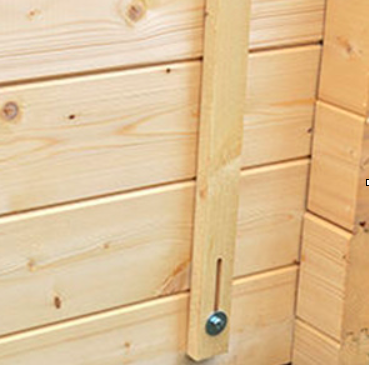
Log settlement is a natural occurrence that happens following the building of a cabin where the wood shrinks and settles. This period of “settling” is caused by the timber reacting and adapting to the climate.
The wood continually expands and contracts as it attempts to reach a moisture content balance with its surroundings. This also results from changes in the weather, particularly when it is exceptionally hot or extremely cold.
Low humidity together with dry and warm air in the summer are ideal conditions for contraction and it is therefore particularly common during these months. During the damp, cold winter months, the timber will absorb moisture resulting in the wood expanding slightly.
Gaps can form in the timber due to the shrinking and shifting which can lead to air and water seeping in between the logs.
What can be done to help deal with problems caused by this contraction and expansion?
1. Storm Braces
A majority of log cabins include storm braces. These are long battens of wood fixed at the top and bottom to the 4 corners of the cabin. They can be adjusted by loosening their bolts which closes any gaps in the logs and allows them to settle.
How do storm braces work?
They secure the top walls logs to the bottom wall logs which are held down by the weight of the cabin.
* Attach to the top and bottom of the walls with a nut and bolt
* There is a slot at the bottom for the bolt to go through which enables the storm bar to move up and down while the walls settle and then expand and contract.
* You may need to release the tension from the top bolt to permit the storm brace to move freely. It is important to check this regularly throughout the cabin’s life to prevent gaps between the logs.
Click here for handy video: How to Install Storm Braces

2. Treat the cabin walls inside and out
The natural occurrence of the wall logs expanding and contracting can be limited by applying a treatment to the exterior walls.
Without treatment, the wood is continually exposed to the elements throughout the year. The moisture it takes in during wet conditions causes expansion and when the moisture dries out during sunny conditions it causes contraction. These continual movements in the wood can result in gaps in the walls. Treating the cabin produces a waterproof layer on top of the wood, inhibiting the moisture levels from changing.
It’s important to treat the exterior of the cabin with a suitable treatment as soon as possible after it has been built – ideally in the first week and certainly within 4-6 weeks. This will repel water and condensation from the logs.
Choose a treatment that allows the moisture inside the logs to make its way out.
- It’s vital the timber is completely covered, including all the sides and edges of the eaves and apex fascia boards
- Paint the windows and doors on every surface, including the battens, to stop warping and swelling.
*Recommendation* – Cuprinol Wood Preserver
It’s advisable to treat the floor and roof boards before the cabin is built:
- The underside of the flooboards will be protected from rising damp and prevent any moisture from penetrating the boards
- The roof boards need treating to stop air moisture seeping into them which can lead to lifting and swelling, particlarly where there is high humidity.
It’s important to remember to also treat the interior walls of the cabin to prevent moisture building up inside and reduce any movement further.
See my blog How to Treat a Log Cabin for advice.
